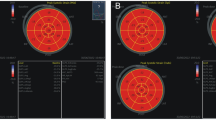Abstract
Myocardial ischemia changes the electrophysiological properties of the myocardium, but it is difficult to detect the abnormalities of depolarization and repolarization noninvasively in patients with coronary artery disease. Depolarization and repolarization abnormalities were retrospectively investigated in 61 patients (48 males and 13 females) with coronary artery lesions (CALs) caused by Kawasaki disease (KD) from 2007 to 2014 using magnetocardiography (MCG). CAL had been diagnosed by selective coronary angiography. The integral value was computed for each channel, and isointegral maps were constructed during depolarization and repolarization. The MCG findings were compared between the stenotic lesions group (SL group) and the non-stenotic lesions group (non-SL group). The incidence of MCG abnormalities was significantly higher in the SL group than in the non-SL group (p < 0.0001). The incidence of abnormal repolarization was significantly higher than that of abnormal depolarization (p < 0.0001). The number of coronary artery occlusions significantly affected the severity of abnormal repolarization (p = 0.02). Six (75%) of the patients with abnormal depolarization had a previous anteroseptal myocardial infarction. The transmural myocardial infarction affects on abnormalities of depolarization, and the non-transmural myocardial infarction might relate on abnormalities of repolarization. The myocardial electrical properties were preserved in patients except very severe coronary stenosis. MCG is possible to detect electrical myocardial abnormalities noninvasively in patients with CALs caused by KD.








Similar content being viewed by others
Change history
17 April 2019
In the original publication of the article, the sentence “The integral value was computed for each channel, and isointegral maps were constructed during depolarization and repolarization.” was published incorrectly under the abstract section.
References
Tsuda E, Hirata T, Matsuo O, Abe T, Sugiyama H, Yamada O (2011) The 30-year outcome for patients after myocardial infarction due to coronary artery lesions caused by Kawasaki disease. Pediatr Cardiol 32:176–182
Izumida N, Asano T, Hosaki J, Sakurada H, Motomiya T, Kawano S, Sawanobori T, Hiraoka M (1998) Non-dipolarity of heart potentials estimated by magnetocardiography in normal subjects. Jpn Heart J 39:731–742
Tsukada K, Miyashita T, Kandori A, Yamada S, Sato M, Terada Y, Mitsui T, Yamaguchi I, Kanzaki H, Kamakura S, Miyatake K (2000) Magnetocardiographic mapping characteristic for diagnosis of ischemic heart disease. Comput Cardiol 27:505–508
Hailer B, Van Leeuwen P, Chaikovsky I, Auth-Eisernitz S, Schafer H, Gronemeyer D (2005) The value of magnetocardiology in the course of coronary intervention. Ann Noninvasive Electrocardiol 10:188–196
Kawakami S, Takaki H, Hashimoto S, Kimura Y, Nakashima T, Aiba T, Kusano KF, Kamakura S, Yasuda S, Sugimachi M (2016) Utility of high-resolution magnetocardiography to predict later cardiac events in nonischemic cardiomyopathy patients with normal QRS duration. Circ J 81:44–51
Kandori A, Ogata K, Miyashita T, Watanabe Y, Tanaka K, Murakami M, Oka Y, Takaki H, Hashimoto S, Yamada Y, Komamura K, Shimizu W, Kamakura S, Watanabe S, Yamaguchi I (2008) Standard template of adult magnetocardiogram. Ann Noninvasive Electrocardiol 13:391–400
Kandori A, Ogata K, Watanabe Y, Takuma N, Tanaka K, Murakami M, Miyashita T, Sasaki N, Oka Y (2008) Space-time database for standardization of adult magnetocardiogram-making standard MCG parameters. Pacing Clin Electrophysiol 31:422–431
Hailer B, Chaikovsky I, Auth-Eisernitz S, Schafer H, Van Leeuwen P (2005) The value of magnetocardiology in patients with and without relevant stenoses of the coronary arteries using an unshielded system. PACE 28:8–16
Tsuda E, Tsuii N, Hayama Y (2018) Stenotic lesions and the maximum diameter of coronary artery aneurysms in Kawasaki disease. J Pediatr 194:165–170
Nakaoka H, Tsuda E, Morita S (2018) Evaluation of left ventricular function by magnetic resonance in patients with asymptomatic coronary artery occlusion after Kawasaki disease. In: The 12th international Kawasaki disease symposium, Yokohama
Morguet AJ, Behrens S, Kosch O, Lange C, Zabel M, Selbig D, Munz DL, Schultheiss HP, Koch H (2004) Myocardial viability evaluation using magnetocardiography in patients with coronary artery disease. Coron Artery Dis 15:155–162
Hailer B, Van Leeuwen P, Lange S, Wehr M (1998) Value of spatial dispersion of the magnetocardiographically determined QT intervals and its components in identification of patients at risk for arrhythmia after myocardial infarction. Ann Noninvasive Electrocardiol 3:311
Tsukada K, Miyashita T, Kandori A, Mitsui T, Terada Y, Sato M, Shiono J, Horigome H, Yamada S, Yamaguchi I (2000) An iso-integral mapping technique using magnetocardiogram, and its possible use for diagnosis of ishemic heart disease. Int J Cardiac Imag 16:55–66
Funding
This study had no financial support.
Author information
Authors and Affiliations
Corresponding author
Ethics declarations
Conflict of interest
The authors state that they have no conflict of interest.
Ethical approval
All procedures performed in studies involving human participants were in accordance with the ethical standards of the institutional committee and with the 1964 Helsinki Declaration and its later amendments or comparable ethical standards.
Additional information
Publisher's Note
Springer Nature remains neutral with regard to jurisdictional claims in published maps and institutional affiliations.
Rights and permissions
About this article
Cite this article
Tamaki, W., Tsuda, E., Hashimoto, S. et al. Magnetocardiographic recognition of abnormal depolarization and repolarization in patients with coronary artery lesions caused by Kawasaki disease. Heart Vessels 34, 1571–1579 (2019). https://doi.org/10.1007/s00380-019-01383-4
Received:
Accepted:
Published:
Issue Date:
DOI: https://doi.org/10.1007/s00380-019-01383-4




